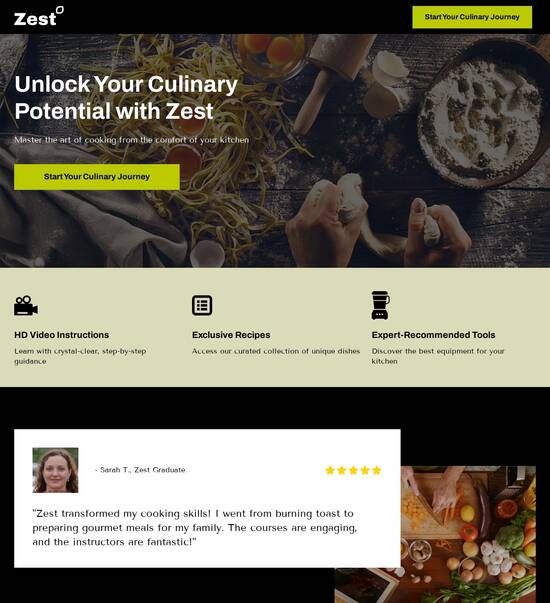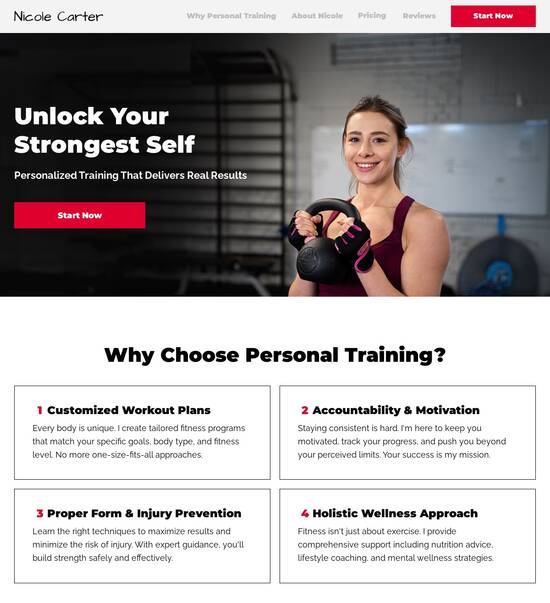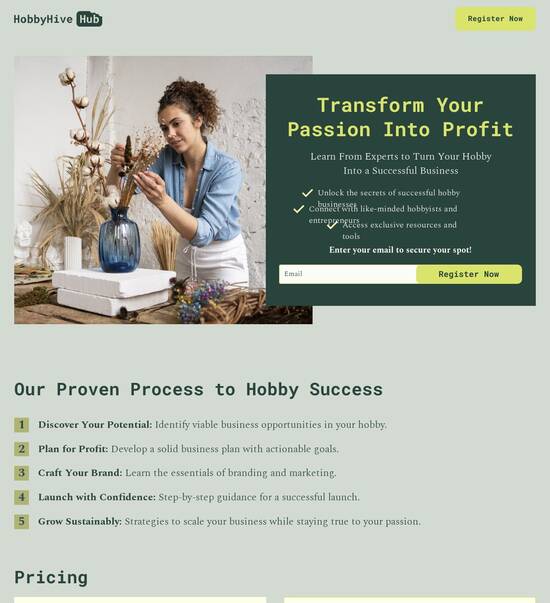
HTML page template for Logistics managers
Use TemplateAbout template
Attract clients and showcase your skills with style using our landing page templates for Logistics managers. Let's convert those visitors into clients!
Recommended templates

Easy to build without coding
With the intuitive drag-and-drop builder, anyone on your team can create high-converting pages without any knowledge of code or design. Make enhancements to your landing page with custom widgets using Javascript, HTML/CSS, or third-party scripts.

Multiple layouts for any industry and goal
Select from 500+ landing page layouts built to boost conversions across industry-specific scenarios. Customize them by adjusting fonts, adding images, and generating on-brand content with the AI assistant. Quickly scale with Instablocks® and Global Blocks that you can save, reuse, and update globally.

Loads fast and looks polished on any device
Every template is responsive, which means they present professionally on any device and load blazingly fast with our Thor Render Engine. You can also power them up with Google AMP technology to deliver an unparalleled mobile experience and drive higher conversions.

Robust analytics & experimentation
Get real-time updates and reporting across all your devices, showing the number of visitors, conversions, cost-per-visitor, and cost-per-lead. Launch AI-powered experiments, run A/B tests, and use heatmaps to analyze user behavior, then optimize your landing page to maximize conversions.







Easy to build without coding
With the intuitive drag-and-drop builder, anyone on your team can create high-converting pages without any knowledge of code or design. Make enhancements to your landing page with custom widgets using Javascript, HTML/CSS, or third-party scripts.
Multiple layouts for any industry and goal
Select from 500+ landing page layouts built to boost conversions across industry-specific scenarios. Customize them by adjusting fonts, adding images, and generating on-brand content with the AI assistant. Quickly scale with Instablocks® and Global Blocks that you can save, reuse, and update globally.
Loads fast and looks polished on any device
Every template is responsive, which means they present professionally on any device and load blazingly fast with our Thor Render Engine.
Robust analytics & experimentation
Get real-time updates and reporting across all your devices, showing the number of visitors, conversions, cost-per-visitor, and cost-per-lead. Launch AI-powered experiments, run A/B tests, and use heatmaps to analyze user behavior, then optimize your landing page to maximize conversions.
All the features you need to build lead-generating landing pages
Explore more featuresLearn how to build top-performing landing pages for any goal
FAQs
Leading the way in building high-performing landing pages





Mastering Instapage: Your ultimate guide to landing page optimization
Instapage stands out as a premier platform for marketers eager to accelerate their campaigns with robust landing page solutions. From customizable templates to powerful optimization tools, marketers in sectors such as business services, tech, and education can effectively enhance their conversion rates and drive significant ROI.
Understanding the power of Instapage
With Instapage, you gain access to over 100 high-converting templates that make building landing pages straightforward and efficient. The platform is designed for both seasoned marketers and those new to the digital marketing landscape, ensuring accessibility and effectiveness.
- High-converting templates: Leverage professional designs optimized for conversions, saving time and effort.
- Intuitive drag-and-drop builder: Easily customize layouts without any coding knowledge.
- Pre-built lead generation elements: Enhance your pages with forms, buttons, and other conversion tools.
Step 1: Building your landing page
Begin by selecting a template that aligns with your marketing goals. With Instapage, you can customize every facet of the template to fit your brand's unique voice and positioning.
Step 2: Optimizing for conversions
After your landing page is created, utilize the optimization features to enhance performance. Employ A/B testing to determine the most effective elements.
- Implement A/B tests: Experiment with different headlines and calls-to-action to see what resonates more with your audience.
- Use heatmaps: Analyze user interactions to identify areas for improvement.
- Check analytics: Regularly consult the analytics dashboard to track visitor behavior and page performance.
Step 3: Personalizing user experience
Considering the diverse needs of your audience, personalization is key. Instapage provides features for dynamic text replacement and audience-specific tracking.
- Dynamic text replacement: Tailor messages based on the user's search queries.
- AdMaps: Align specific ads to corresponding landing pages for a cohesive user experience.
- Audience metrics: Utilize detailed data insights to fine-tune your campaigns.
By following these steps, you can leverage Instapage to transform your marketing campaigns and achieve higher conversions.
Ready to optimize your landing pages with Instapage? Start a free trial today and unlock the potential of effective digital marketing.
People also ask about HTML page template for Logistics managers
HTML page template for logistics managers
Understanding the essentials of an HTML page template for logistics managers
Creating an effective HTML page template tailored for logistics managers requires a deep understanding of their unique needs and challenges. Logistics managers play a crucial role in the supply chain, overseeing functions that ensure the smooth movement of goods from manufacturers to consumers. Thus, their digital tools must reflect the complexities of their duties while remaining user-friendly and efficient.
Defining the unique needs of logistics managers
Logistics managers juggle a variety of responsibilities, including supply chain oversight, inventory management, and transportation coordination. Each of these functions requires a clear focus to ensure that operations run smoothly and efficiently. Effective logistics management is centered on three primary objectives: improving operational efficiency, minimizing costs, and enhancing communication across all stakeholders in the supply chain.
However, achieving these goals is often fraught with challenges. Logistics managers must constantly adapt to fluctuating market demands, navigate complex regulatory environments, and ensure that their teams are well-informed and capable of executing strategies swiftly. As such, the tools they use, including HTML page templates, must be explicitly designed to address these challenges.
The role of an HTML page template in streamlining logistics operations
One of the main advantages of using HTML page templates is their ability to simplify complex logistics information. A well-structured template allows logistics managers to present vital data clearly and accessibly, making it easier for users to digest information quickly. Predefined layouts can help standardize communication, ensuring consistency in branding across digital platforms. This facilitates a professional appearance, which is essential in establishing trust with clients and partners.
Additionally, it is crucial that these templates are responsive. Today’s logistics managers are often on the go, requiring access to information on various devices, from desktops to mobile phones. Templates that adapt fluidly to different screen sizes and resolutions will allow managers to communicate effectively with their team and stakeholders, regardless of where they are or what device they are using.
Essential features of a logistics manager template
When designing an HTML page template intended for logistics managers, several features must be prioritized. Structured navigation is essential for an optimal user experience. By keeping an intuitive layout, managers can quickly find the categories relevant to their transport and shipping options, minimizing the time spent locating needed information.
Furthermore, integrating interactive components can significantly enhance the functionality of logistics templates. For example, allowing users to filter through various data sets in real-time can provide immediate insights into inventory levels or shipment timelines. Incorporating interactive charts and graphs can also help users visualize complex data sets, making it easier to assess performance metrics or inventory trends.
Structured navigation for quick access to crucial information.
Interactive components for real-time data filtering and visualization.
Integration capabilities with existing logistics software solutions to enhance usability.
Leveraging innovative coding techniques
Innovative coding techniques can optimize HTML page templates, improving their performance and user experience. For instance, implementing lazy loading using `iolazy` can significantly enhance page loading speeds by ensuring that only essential content is loaded initially. This approach is especially beneficial for logistics templates where large datasets, such as shipping details or inventory levels, can delay the loading process.
Additionally, enhancing responsiveness with `document.addEventListener` can support dynamic content updates. This technique allows template developers to create custom events that can enhance user interactions, ensuring that users receive the most pertinent information in real-time, thus streamlining communications within logistics operations.
Enhancing user interaction with ‘DOMContentLoaded’
Understanding the significance of the DOMContentLoaded event is crucial for creating user-friendly logistics templates. This event ensures that important content is fully loaded before users interact with the page, contributing to a more satisfying user experience. As a result, logistics managers are less likely to experience frustrations due to incomplete information when they first access a template.
Practical implementations of DOMContentLoaded can range from triggering animations to loading interactive modules. For logistics-specific needs, prioritizing content ensures that critical information, such as shipment statuses or inventory alerts, is readily accessible. By focusing on what matters most to their users, logistics managers can facilitate better decision-making processes.
Visual appeal through customizable design elements
Customizable design elements can play a significant role in creating effective HTML page templates tailored to specific logistics niches. For example, layouts designed for air freight may prioritize clear flight routing maps, while templates for ground transportation might focus on optimizing delivery routes. Such targeted approaches ensure that the design meets the unique demands of varying logistical services.
In addition, selecting the right typography and color schemes is essential to establish a professional appearance. A cohesive color palette can enhance brand recognition while maintaining legibility across all elements of the template. Ensuring that text is easy to read and aligns with the brand identity fosters trust among users and clients alike.
Measuring success: Analytics and feedback integration
To maintain efficiency in logistics operations, managers should leverage data-driven decisions. By tracking user behavior on HTML templates, logistics managers can gain critical insights into how their teams interact with these resources. They can then identify key performance indicators (KPIs) that directly correlate with landing page performance, such as user engagement rates or time spent on critical functions.
Furthermore, integrating tools for feedback collection is vital for continuous improvement. Conducting surveys and user testing can illuminate areas in which logistics templates excel or fall short. Additionally, employing A/B testing strategies can help optimize various template features to align better with user needs and operational goals.
Case studies: Successful implementations of HTML templates in logistics
Examining specific logistics firms that have successfully implemented HTML templates can provide valuable insights into best practices. For instance, a case study of a large e-commerce company revealed that tailored templates significantly improved their shipping processes. By making shipping status easily accessible and streamlining orders through a structured format, they enhanced customer satisfaction.
Conversely, another study highlighted a traditional retail logistics firm that struggled with template adoption due to an overly complex design. This experience underscored the importance of versatility in template applications and the need to match designs to specific operational scenarios.
Future trends in logistics HTML page template design
As the logistics industry continues to undergo digital transformation, the future of HTML page template design is likely to evolve significantly. Strategies incorporating artificial intelligence and machine learning will enable templates to adapt to changing user needs. This evolution may set new standards for user expectations, pushing logistics managers to adopt templates that are not only functional but also predictive in their design.
Moreover, as user behavior continues to shift, adapting design principles to accommodate these changes will be essential. Ongoing education for logistics managers in web technologies will empower them to effectively utilize these evolving tools, driving efficiency and improving operational capabilities over time.
Optimizing template performance: Best practices
To ensure that HTML templates function optimally in logistics operations, speed optimization should be a priority. Techniques like image compression and mindful selection of file formats can drastically reduce loading times. Hand in hand with this, streamlining code, such as minimizing unnecessary scripts, will result in a smoother user experience.
Accessibility considerations are equally important, as diverse users interact with these templates. Implementing ARIA labels and adhering to proper markup standards ensures that all users can access information effectively. Additionally, employing a mobile-first design strategy will enhance usability for those accessing templates on smartphones and tablets, which is critical in the logistics sector.
Ready to skyrocket conversions?
Supercharge your ad campaigns with high-performing landing pages
Get started














